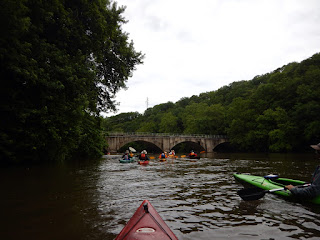Day 6 of the Sojourn started out by taking us down the Schuylkill Canal near Phoenixville!
Paddling the canal was a pretty interesting detour. We veered off to pass through Lock 60, and slowed down to paddle a parallel, man-made version of the river that carried tons of coal, lumber, and textiles to Philadelphia in the 1800s and early 1900s. Just a few hours later, after Valley Forge, it felt like a different world when we came across 422 bridge construction.
The blue bridge of 476 signaled the approach of our last night's camp in West Conshocken, and the landscape slowly but surely started to feel more urban. As the day wound down, we heard more and more trains and cars, even as we continued to paddle past trees. Incredibly, just before this spot we also spotted a Bald Eagle flying overheard!
Our last day was blue skies and sun, and the clouds, rain and choppy water of Port Clinton felt like a million years ago.
Our last portage of the Sojourn included our last safety talk by Allan Quant of Canoe Susquehanna, as we approached a patch of whitewater after the Flat Rock Dam!
During the portage stop, I was, of course, busy listening to the safety talk! But, I was also pretty stoked to stop for a second and check out this fish ladder on the dam, something I had been looking forward to all week! Dams halt the journeys of migratory fish and eels, as migratory species swimming upriver to spawn can't swim up the dam. Dams along the Schuylkill (like many other rivers) have irrevocably changed wildlife populations in the river. However, installing fish ladders has provided a way forward for the return of migratory species, such as shad! Fish ladders slow down and angle the water flow to a speed that fish can manage on their epic journeys upstream (some swim all the way from the Atlantic!). However, much more work remains to rebuild habitat on the river for fish and other wildlife. As I looked down on the fish ladder, I thought about a talk by one of our incredible speakers this week, Richard Horowitz, PhD, the Drexel University Professor and Fisheries Section Leader at the Academy of Natural Sciences. Dr. Horowitz spoke with us about fish in the Schuylkill River watershed way back on Sunday, in Muhlenberg at Jim Dietrich Park.
Dr. Horowitz shared that we will never truly know the extent of the biodiversity and abundance of the Schuylkill before dams, industrial pollution, deforestation, and the filling in of wetlands and estuaries took their toll on wildlife habitat and water quality. However, his key take-away was an incredible enthusiasm about the diversity of life the Schuylkill supports, especially as the river continues to be restored! If we continue to work to protect the Schuylkill, and increase our efforts, it's very exciting to wonder about the future discoveries that remain to be made by studying the biology, ecology, and resilience of the Schuylkill. As I tested the water all week, it was truly incredible to see indicators of high levels of water quality.
More and more bridges as we approached Philadelphia!
The river provides a pretty interesting viewpoint of moments like this from Manayunk, where brand new condos have been built right next to old, intricate stone walls. The conservation challenges have shifted with time and economic development as well, as we now work to slow down the journey of storm water from roofs and pavement!
Philadelphia Water Authority Treatment Plant!

Lunch at the Philadelphia Canoe Club!
The awarding of the Stickers for full trip participants!
I am going to miss spending every day being surrounded by the colorful sea of kayaks.
Turtles and storm drains!
As we paddled towards the city, the banks changed from wooded and industrial, and the river became a place of recreation and so much urban life on a sunny Friday afternoon. Scullers passed us as we paddled past joggers, cyclists, and plenty of people out enjoying the afternoon on the grass!

Finally, we reached Boathouse Row and that Philly Skyline!!
Growing up outside of Reading, the part of the river that is most familiar to me is by Birdsboro. I spent many lazy summer days tubing and swimming on that stretch of the river, and plotting with my sisters to someday go all the way from Reading to Boathouse Row. And it happened! (I left my sisters behind though. Maybe I can convince them to join the Sojourn next summer....)
Packing up was pretty surreal, as we hauled ourselves and our boats into the city. A day later, it's still strange that the Sojourn is over. I am compiling all of my data from testing the water quality, so check back soon to find out my conclusions!



















































